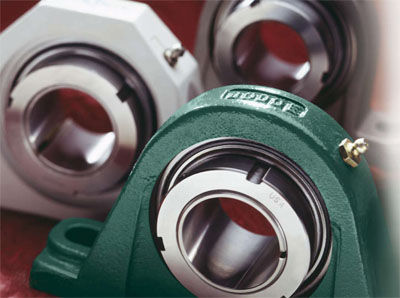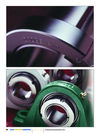“The aggressive nature of tire shredding meant that repairing these machines was taking up far too much of our time, and reducing our productivity,” says Andy Booth, reliability manager at Sapphire.
Replacing the bearings could take up to two hours per piece. In some cases, corrosion meant the bearings needed to be loosened by heat. In other circumstances, the entire shaft had to be replaced. The end result was an expensive repair problem. Booth called Bearing Transmission & Pneumatics for help.
Bearing Transmission & Pneumatics suggested a specific type of ball bearing from Baldor called the Dodge Grip Tight. “Our work means that we tend to see a lot of bearing failures, and we’ve come to regard the Dodge Grip Tight as a genuine problem solver,” says Edward Fielding of Bearing Transmission & Pneumatics. “Although the major requirement was to simplify changeover, this bearing also manages to survive much longer in hostile operating conditions.”
The Dodge Grip Tight is an adapter-style bearing with a mechanical feature that loosens it by simply turning a nut. This automatically pulls the bearing off, avoiding forcible
removal or expansion heating. The Grip Tight includes a built-in flinger seal for protection in hostile environments.

According to the company’s press release, the Grip Tight bearings were more expensive than the sets-crew type Sapphire had been using. Demonstrations and testing convinced Booth and his team that the easy-off mechanism would make changeovers a predictable operation.
Booth purchased the Grip Tight bearings and began
installing them at Sapphire. Following a 24-month period, operators can now replace the bearings start to finish in 15 minutes. Booth reports no shaft damage to date, and the bearings have lasted twice as long as previous models.
“Grip Tight bearings have given us back predictability of maintenance, with the welcome bonus of much longer life, protecting some of our company’s most crucial assets,” says Booth. “Our operational team now has the time to be more proactive, focusing its major efforts on preventive maintenance rather than breakdown maintenance.”
Twin City Challenge
When Twin City Fan & Blower needed to compete for the business of three automotive plants, they had to face the challenges of improving fan designs, tightening up shafting tolerances and lowering vibration to get the contracts. The fans would have to meet an automotive specification in which the allowed maximum vibration amplitudes were far below industry standards.
“We could either sit on the sidelines, or we could be aggressive and say ‘Yes we can meet these specs,’” says Dick Williamson, engineering vice president for Twin City Fan. “We made the commitment to make it happen, and we got to work.”






